
June 4
1867 Finland: Birth: Carl Gustaf Mannerheim: Military leader and president:
Gustaf Mannerheim was born . . . into a wealthy family [and] was to command Finland's military during the Winter War from 1939-1940 when Russia attacked after her occupation of eastern Poland at the start of World War Two. At the age of fourteen, Mannerheim was sent to the Military Cadet School in Hamina--though Finland's future military commander was expelled for disciplinary reasons. In 1887, Mannerheim decided to enrol into the Russian army and he served in the Alexandrijski Dragoons, a regiment quartered in Poland. He was later transferred to St. Petersburg. . . .
Mannerheim took part in the Russo-Japanese war of 1904-05 and was promoted to colonel in the battlefield. In 1906, Mannerheim was offered a special military commission to China. . . . In 1911, Mannerheim was promoted to Major-General and he made his name during World War One. He was promoted to Lieutenant-General and was awarded the Cross of St George – the highest military award an officer in the Russian Army could receive.
The Russian Revolution of 1917 ended his career in the Russian Army and in December 1917 Mannerheim returned to a Finland that was both independent of Russian rule but also divided by revolutionary disturbances. The Finnish parliament gave Mannerheim the task of forming a Finnish Army that had the primary task of restoring Finland to stability. Mannerheim disarmed the 40,000 Russian troops still stationed in Finland and, after a three-month campaign, put down the rebels. By May 1918, Finland had been restored to relative calm.
However, Mannerheim fell out with Finland's Senate. He was wary of their pro-German stance and resigned his post and went abroad in an attempt to influence countries that he believed were clearly going to win the war. Mannerheim believed that Britain and France needed to be allies of the newly created Finland if the nation was to survive. In December 1918, Mannerheim returned to Finland and stood in the country's presidential elections--losing to K Stahlberg. Mannerheim signed the constitution of Finland in July 1919.
Mannerheim encouraged Finland to take part in the anti-Bolshevik campaign during the Russian Civil War, but the failure of this led to him retiring from the military. In civilian life he worked for the Red Cross and established the Mannerheim League for Child Welfare. In 1933, he was awarded the title of Field Marshall in recognition of the work he had done in the military. He constructed a series of defence lines for Finland--known as the Mannerheim Line--across her south-east border. Though he was critical of Nazism, he participated in visits to Finland by Nazi leaders--including Goering's hunting trips.
When Russia attacked Finland in November 1939, Mannerheim was appointed Commander-in-Chief of the Armed Forces of Finland. As well as fighting a military campaign against the Russians, Mannerheim was also concerned that Finland should not be seen as being pro-Germany and as a result of this he developed a political role as well as his military one.
In 1942, Mannerheim was appointed Marshall of Finland and in that year Hitler visited Finland to offer his congratulations. In a later visit to Germany , Mannerheim was received by Hitler.
In August 1944, Mannerheim was appointed President of Finland by the nation's parliament in an attempt to get a separate peace settlement with the advancing Red Army of Russia. Finland withdrew from the war in September 1944.
In 1946, Mannerheim resigned his presidency due to poor health. He moved to Switzerland and spent his last few years in relative quiet. Gustaf Mannerheim died in January 1951 at Lausanne in Switzerland aged 83. His body was returned to Finland where it was buried with full military honours in a hero's cemetery. [For further information, click here.]
1877 Birth: Heinrich Wieland:
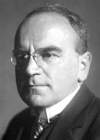
German biochemist, Nobel Prize in Chemistry for his research into the bile acids. Wieland tried successfully to protect people, especially Jewish students, who were "racially burdened" after the Nuremberg Laws. Students who were expelled because they were "racially burdened" could stay in Heinrich Wieland's group as chemists or as "Gaeste des Geheimrats" (guests of the privy councilor).
1878 Turkey cedes Cyprus to Britain:
The sultan ceded the administration of Cyprus to Britain in exchange for guarantees that Britain would use the island as a base to protect the Ottoman Empire against possible Russian aggression. The British had been offered Cyprus three times (in 1833, 1841, and 1845) before accepting it in 1878 . . . . In June 1878, clandestine negotiations between Britain and the Porte culminated in the Cyprus Convention, by which "His Imperial Majesty the Sultan further consents to assign the island of Cyprus to be occupied and administered by England." [For further details, Click here]

1896 USA: Henry Ford makes a successful pre-dawn test run of his horseless carriage, called a quadricycle, through the streets of Detroit. (AP)
1915 World War I: List Regiment:
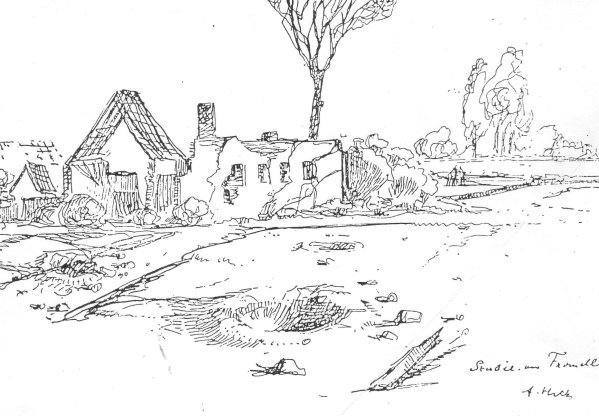
Gefreiter Adolf Hitler's 16 Reserve Infantry Regiment continues to occupy a position at Fromelles, pictured above in a drawing by Hitler, which is on a level field with water channels, willow trees and willow stalks. In the distance towards the enemy lines lies an insignificant wood with barbed wire entanglements. Under the direction of their defense-minded commander, Lieutenant General Gustav Scanzoni von Lichtenfels, the regiment works ceaselessly day and night to further fortify their position at Fromelles while fighting off repeated assaults by the enemy. [For further details, Click here.]
1916 World War I: Various:
Brusilov Offensive: On this day in 1916, the Battle of Lutsk marks the beginning of the Brusilov Offensive, the largest and most successful Allied offensive of World War I.
[For further details, Click here. For General von Cramon on the Brusilov Offensive Click here]
1916 List Regiment: Gefreiter Adolf Hitler endures trench warfare in Flanders (Artois) with 3 Company, 16 Reserve Infantry Regiment [List Regiment]. [For further details, Click here.]
1917 World War I: Various:
Brazil: Letter from Domicio da Gama, Brazilian Ambassador to the United States, to Robert Lansing, US Secretary of State:
The President of the Republic has just instructed me to inform your Excellency's Government that he has approved the law which revokes Brazil's neutrality in the war between the United States of America and the German Empire. The republic thus recognized the fact that one of the belligerents is a constituent portion of the American Continent and that we are bound to that belligerent by traditional friendship and the same sentiment in the defence of the vital interests of America and the accepted principles of law. [For further details, Click here]
List Regiment: Gefreiter Adolf Hitler's 16th RIR redeploy east of Douai for a period of rest which will extend until June 24. [For further details, Click here.]
1918 World War (June 1-17): List Regiment: The 16th RIR hold the Front at Aisne and the Marne. [For further details, Click here.]
1920 Versailles: Treaty of Trianon:
[The peace treaty was] signed in the Grand Trianon villa at Versailles, near Paris, by Hungary and the victorious Allied powers after World War I. (The earlier Treaty of St. Germain had separated Hungary from Austria.) The terms of the treaty, greatly resented by the Hungarian people, divested Hungary of almost three-fourths of its former territory. Czechoslovakia received Slovakia and the Ruthenian region. Austria was given a strip of western Hungary called the Burgenland. The Kingdom of the Serbs, Croats, and Slovenes (later Yugoslavia) received Croatia, Slavonia, and part of the Banat. The rest of the Banat and Transylvania went to Romania.
Among other Hungarian territorial losses was the Adriatic port of Fiume (now Rijeka, Yugoslavia), Hungary's only seaport. The treaty also limited the Hungarian army to 35,000 men and provided that Hungary make reparations payments to Allied nations to compensate for war damages.
1931 Heydrich:
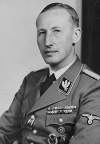
Himmler is first introduced to Reinhardt Heydrich at Waldtrudering, where Himmler is recovering from a recent illness. After a brief written examination outlining plans for a new SS intelligence unit, Himmler offers Heydrich a position on his headquarters staff. Himmler is greatly impressed by Heydrich's Nordic appearance. (THP) [See below 1942]
1932 Weimar: President Hindenburg dissolves the Reichstag:
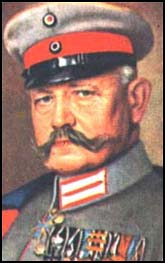
In April of 1932, Heinrich Bruening, Chancellor of Germany, invoked Article 48 of the constitution and issued a decree banning the SA and SS all across Germany. The Nazis were outraged and wanted Hitler to fight the ban. But Hitler, always a step ahead of them all, knew better. He agreed, knowing the republic was on its last legs and that opportunity would soon come along for him.
That opportunity came in the form of Kurt von Schleicher, a scheming, ambitious Army officer who had ideas of leading Germany himself. But he made the mistake (that would prove fatal) of underestimating Hitler. Schleicher was acquainted with Hitler and had been the one who arranged for Hitler to meet Hindenburg, a meeting that went poorly for Hitler.
On May 8, 1932, Schleicher held a secret meeting with Hitler and offered a proposal. The ban on the SA and SS would be lifted, the Reichstag dissolved and new elections called, and Chancellor Bruening would be dumped, if Hitler would support him in a conservative nationalist government. Hitler agreed . . . .
Heinrich Bruening was one of the last men in Germany who stood up to Hitler with the best interest of the people at heart. He was responsible for getting Hindenburg re-elected as president to keep out Hitler and preserve the republic. He was also hard at work on the international scene to help the German economy by seeking an end to war reparations. But his economic policies at home brought dismal results. As Germany's economic situation got worse, with nearly six million unemployed, Bruening was labeled "The Hunger Chancellor." Bruening had also continued the dangerous precedent of ruling by decree. He invoked Article 48 of the German constitution several times to break the political stalemate in Berlin.
To Schleicher and Hitler, he was simply in the way and had to go. Schleicher went to work on him by undermining the support of Hindenburg. Bruening was already in trouble with Hindenburg, who blamed him for the political turmoil that had made it necessary to run for re-election at age 85 against the 'Bohemian Corporal' Adolf Hitler.
Bruening also made an error in proposing that the huge estates of bankrupt aristocrats be divided up and given to peasants, sounding like a Marxist. Those same aristocrats, along with big industrialists, had scraped together the money to buy Hindenburg an estate of his own. When Hindenburg took his Easter vacation there in mid-May, he had to listen to their complaints about Bruening. All the while, Schleicher was at work against Bruening as well. On May 29, 1932, Hindenburg called in Bruening and told him to resign. The next day, Heinrich Bruening handed in his resignation, effectively ending democracy in Germany.
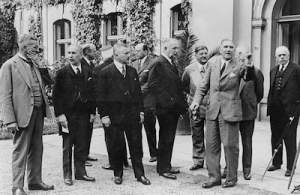
Chancellor Franz von Papen (third from right) with his Cabinet
Schleicher was now in control. He chose as his puppet chancellor, an unknown socialite named Franz von Papen who had grave doubts about his own ability to function in such a high office. Hindenburg, however, took a liking to Papen and encouraged him to take the job. The aristocratic Papen assembled a cabinet of men like himself. This ineffective cabinet of aristocrats and industrialists presided over a nation that would soon be on the verge of anarchy.
When Adolf Hitler was asked by President Hindenburg if he would support Papen as chancellor, he said yes. On June 4, the Reichstag was dissolved and new elections were called for the end of July. On June 15, the ban on the SA and SS was lifted. The secret promises made to the Nazis by Schleicher had been fulfilled. [For further details, Click here]
1934 USA: FDR asks for drought-relief funds:
On this day in 1934, President Franklin Roosevelt asks Congress to appropriate $52.5 million to battle economic and social disaster in the American Midwest caused in part by a series of droughts in the Great Plains region.
A series of great droughts that began in the 1920s and a history of poor land-management practices had created a Dust Bowl in the Great Plains by the 1930s, exacerbating the already difficult economic conditions of the Great Depression for hundreds of thousands of Americans. For days at a time, as an Oklahoma observer wrote, thick clouds of dust blotted out the sun. As water ran out and crops dried up, farmers migrated to other parts of the nation to find jobs. Farm-related businesses, including banks, were forced to close, creating even more unemployment. An influx of Dust Bowl refugees into industrial urban areas and the more productive agricultural areas of the West drove down wages, and created competition among workers, which in turn added to social unrest. By 1934, the economic situation had deteriorated to the point where violent labor-management clashes resulted in the deaths of many workers across the country. [For further information, click here.]
1936 France: Leon Blum—premier of France:
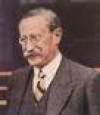
Leon Blum was born in Paris, France, on 9th April, 1872. The son of Jewish parents, he studied law at the Sorbonne where he was converted to socialism
. . . . He was handed over to the Germans who held him prisoner until 1945. Leon Blum died on 30th March, 1950.
[For further details, Click here]

1939 Holocaust: The St. Louis—carrying more than 900 Jewish refugees from Germany—is turned away from the Florida coast.
1940 World War II:Various:
Norway: The Allies begin evacuating their troops.
Dunkirk evacuation ends:
By May 24, Walther von Brauchitsch, the German army commander in chief, was poised to take Dunkirk, the last port available for the withdrawal of the mass of the BEF from Europe. Fortunately for the Allies, Nazi leader Adolf Hitler suddenly intervened, halting the German advance. Hitler had been assured by Hermann Goering, head of the Luftwaffe, that his aircraft could destroy the Allied forces trapped on the beaches at Dunkirk, so Hitler ordered the forces besieging Dunkirk to pull back.
On May 26, the British finally initiated Operation Dynamo: the evacuation of Allied forces from Dunkirk. The next day, the Allies learned that King Leopold III of Belgium was surrendering, and the Germans resumed the land attack on Dunkirk. By then, the British had fortified their defenses, but the Germans would not be held for long, and the evacuation was escalated. As there were not enough ships to transport the huge masses of men stranded at Dunkirk, the British Admiralty called on all British citizens in possession of sea-worthy vessels to lend their ships to the effort. Fishing boats, pleasure yachts, lifeboats, and other civilian ships raced to Dunkirk, braving mines, bombs, and torpedoes.
During the evacuation, the Royal Air Force (RAF) successfully resisted the Luftwaffe, saving the operation from failure. Still, the German fighters bombarded the beach, destroyed numerous vessels, and pursued other ships within a few miles of the English coast. The harbor at Dunkirk was bombed out of use, and small civilian vessels had to ferry the soldiers from the beaches to the warships waiting at sea. But for nine days, the evacuation continued, a miracle to the Allied commanders who had expected disaster. By June 4, when the Germans closed in and the operation came to an end, 198,000 British and 140,000 French troops were saved. These experienced soldiers would play a crucial role in future resistance against Nazi Germany. [For further details, Click here]
From Churchill's famous speech to the House of Commons:

Even though large tracts of Europe and many old and famous States have fallen or may fall into the grip of the Gestapo and all the odious apparatus of Nazi rule, we shall not flag or fail. We shall go on to the end. We shall fight in France, we shall fight on the seas and oceans, we shall fight with growing confidence and growing strength in the air, we shall defend our island, whatever the cost may be. We shall fight on the beaches, we shall fight on the landing grounds, we shall fight in the fields and in the streets, we shall fight in the hills; we shall never surrender.
[For further details, Click here]
1941 Death: Kaiser Wilhelm II: Last German Emperor of the Second Reich:
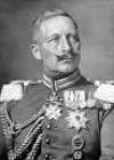
Wilhelm, the son of Prince Frederick Wilhelm of Prussia and Victoria, daughter of Queen Victoria, was born in Berlin in 1859. He received a strict military and academic education at the Kassel Gymnasium and the University of Bonn.
In 1888 Wilhelm II became the 9th King of Prussia and the 3rd Emperor of Germany. Two years later he quarreled and dismissed the German Chancellor, Otto von Bismarck. For the next few years Wilhelm, who loathed parliamentary democracy, acted as an autocratic monarch. A strong opponent of socialism, Wilhelm was a passionate supporter of German militarism and imperialism. Despite the fact he was Queen Victoria's grandson, Wilhelm pursued an anti-British foreign policy. He also gave support to South Africa during the Boer War but later unsuccessfully attempted Anglo-German reconciliation.
In 1908 Wilhelm suffered a nervous breakdown and played a less dominant role in German government for the next few years. However he continued to support German imperialism and backed Alfred von Tirpitz when he suggested building a navy to match the British Navy.
Like his chancellor, Theobald von Bethmann-Hollweg, he encouraged Austro-Hungarian aggression after the assassination of Archduke Franz Ferdinand. Although he favoured a limited war Wilhelm was unhappy when the conflict developed into a world war. Wilhelm was Commander-in-Chief of the armed forces during the First World War. However, the real power was now in the hands of the military, and the decision to replace Erich von Falkenhayn by Paul von Hindenburg, as Army Chief of Staff in August 1916, was taken against his wishes . . . .
William was forced to abdicate on 9th November, 1918. He fled the country with the rest of his family and lived in Holland for the rest of his life . . . .
1942 World War II: Various:
Death: Reinhard Heydrich:
[On] September 27, 1941 Heydrich was appointed acting Reichsprotektor in the Czech puppet state called the Protectorate of Bohemia and Moravia. He replaced Konstantin von Neurath, who remained titular protector until 20 August 1943. Heydrich had his own special plans for the Czechs: his grotesque pseudo-scientific studies concluded that 45% of Czechs could be successfully Germanized, 40% were inferior "mongrels," and 15% were racially intolerable. In a speech in October 1941 he stated: "Bohemia and Moravia must become German, Czechs have no business to be here."
Soon after his arrival, he established a Jewish ghetto at Theresienstadt. He also established a successful policy of offering incentives to Czech workers, rewarding them with food and privileges if they filled Nazi production quotas and displayed loyalty to the Reich. At the same time, Heydrich's Gestapo and SD agents conducted a brutal crackdown of the Czech resistance movement.
SS Obergruppenfuehrer Heydrich was by now a supremely arrogant young man who liked to travel between his country home and headquarters in Prague in an open top green Mercedes car without an armed escort as a show of confidence in his intimidation of the resistance and successful pacification of the population.
But Heydrich's reign was to be short-lived. The British Special Operations Executive had been training teams of dedicated Czech patriots in Cheshire to parachute into their homeland to organise the underground resistance and assassinate the Butcher of Prague. This assassination was nicknamed Operation Anthropoid, and was the bravest and most decisive act to emerge from the Czech resistance movement. A mere two months after Heydrich had moved to the Protectorate, in December 1941, a band of seven assassins parachuted into the country near the town of Lidice. Armed with British weapons and explosives, they quickly went underground and began intelligence-gathering. After spending five months building up a detailed picture of Heydrich's movements, they decided to strike.
On May 27, 1942, four of the men (Lt. Adolf Opalka, Sgt. Josef Valcik, Sgt. Jan Kubis and Sgt. Josef Gabchik) had finally found their opportunity. Heydrich, believing himself to have succeeded in pacifying the Czech population and expecting transfer to France soon, had taken to driving around his dominions in an open-topped, unarmoured Mercedes 320 B, with SS-Oberscharfuehrer Klein behind the wheel. Near the Troja Bridge, Valcik and Opalka kept lookout waiting for the car to, and signalled to the others that it was without a military escort. As the car slowed to turn around a hairpin bend, Gabchik lifted his overcoat and opened fire with his Sten submachine gun. To his horror, the gun jammed, and Heydrich screamed to his driver to run the man down. Jan reacted quickly, realising what had happened, and tossed one of his modified anti-tank grenades at the vehicle. It failed to enter the open-topped car, but ripped through the right wing, embedding fragments of itself and the car into Heydrich's body.
As the Germans [opened fire], the Czechs fled. Heydrich, barely able to walk, staggered out of the vehicle and collapsed on the bonnet. His driver was relatively unharmed, and Heydrich ordered him to pursue the men. He ran after Josef, the men duelling with their pistols as they went, and Josef was able to wound the man and escape.
Author and historian Miroslav Honzik wrote a book about his death and what he has to say is quite remarkable. Heydrich was immediately taken to the Bulovka hospital where they took X-rays of his spine and pelvis. And the diagnosis was: a back injury and lacerated spleen. By noon, the patient was taken for an operation that lasted about sixty minutes. The man who decided about the life and death of millions of Czechs was now fully in the hands of a few doctors. The operation was started by Doctor Hohlbaum, but it was Doctor Walter Dick who soon took over and finished it. The spleen was removed as was a four-by-two-centimeter large piece of metal from Heydrich's back. The doctors of course had to keep in mind that in similar cases patients were often in danger of blood poisoning. Immediately after Heydrich, they operated on his chauffer, Klein. Then the Reichsprotektor was taken back to the operation room where he got a blood transfusion.
In his book published in 1983, academic Prokop Malek pointed out that spleen injury is not fatal and just like Miroslav Honzik, Malek too has doubts about the real cause of Heydrich's death. There were two key moments: more German doctors were summoned to Prague, including the famous surgeon, Professor Sauerbruch. But also present was Himmler's personal doctor, Gebhardt. As Heydrich's immediate superior, Himmler was aware of his subordinate's evil genius. It was said that Heydrich kept files on all of the Third Reich's "prominents," including Hitler himself.
Heydrich felt very good on June 3 and he even sat in his bed and enjoyed his meal. But the next morning he was dead. The autopsy was carried out by two German doctors. One of them, Professor Herwig Hamperl, wrote in his memoirs that there were no pathological changes found on Heydrich's body. He probably died of shock, concluded Hamperl. Well, that's not a very good explanation and author Miroslav Honzik tried to find out more. What he found out was that all the vital documents are lost, including the autopsy report.
There are two possible causes of Heydrich's death: blood poisoning or anaemic shock. Academic Malek claims there were no signs of an infection discovered during the autopsy. After consulting many experts, Honzik was convinced that there was no blood poisoning involved. And shock? Anaemic shock is caused by loss of blood. The patient is in bad shape and refuses to eat. Not likely the case with Heydrich, who ate well only hours before his death. Another thing we know for sure is that the autopsy did not include a toxicological report. The turnaround in his health was so dramatic and the symptoms he displayed so akin to botulin poisoning that there has long been speculation that the modified anti-tank grenades contained the toxin. Although the files on the operation are still sealed, it is known that Paul Fildes, head of the Porton Downs research center that was developing BTX weapons, was involved in the pre-planning stages. He would later claim that the death of Heydrich was "the first notch on my pistol." Despite all efforts Heydrich died in agony in a Prague hospital at the age of 38 . . . .
[Note: I remember reading, many years ago, a book entitled Men with Golden Hands, in which there is a chapter on Heydrich's death. It seemed as though he was given an injection that was not consistent with the removal of his spleen. It is comforting to know, however, that he died in agony, for whatever reason.—Ed.]
The Battle of Midway begins:
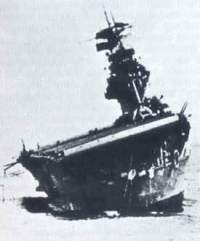
Japanese Admiral Chuichi Nagumo, commander of the fleet that attacked Pearl Harbor, launches a raid on Midway Island with almost the entirety of the Japanese navy.
As part of a strategy to widen its sphere of influence and conquest, the Japanese set their sights on an island group in the central Pacific, Midway, as well as the Aleutians, off the coast of Alaska. They were also hoping to draw the badly wounded U.S. navy into a battle, determined to finish it off.
The American naval forces were depleted: The damaged carrier Yorktown had to be repaired in a mere three days, to be used along with the Enterprise and Hornet, all that was left in the way of aircraft carriers after the bombing at Pearl Harbor.
On the morning of June 4, Admiral Nagumo launched his first strike with 108 aircraft, and did significant damage to U.S. installations at Midway. The Americans struck back time and again at Japanese ships, but accomplished little real damage, losing 65 of their own aircraft in their initial attempts. But Nagumo underestimated the tenacity of both Admiral Chester Nimitz and Admiral Raymond Spruance, commanders of the American forces. He also miscalculated tactically by ordering a second wave of bombers to finish off what he thought was only a remnant of American resistance (the U.S. forces had been able to conceal their position because of reconnaissance that anticipated the Midway strike) before his first wave had sufficient opportunity to rearm.
A fifth major engagement by 55 U.S. dive-bombers took full advantage of Nagumo's confused strategy, and sunk three of the four Japanese carriers, all cluttered with aircraft and fuel trying to launch another attack against what they now realized—too late—was a much larger American naval force than expected. A fourth Japanese carrier, the Hiryu was crippled, but not before its aircraft finished off the noble American Yorktown.
The attack on Midway was an unmitigated disaster for the Japanese, resulting in the loss of 322 aircraft and 3,500 men. They were forced to withdraw from the area before attempting even a landing on the island they sought to conquer. (History.com)
1943 World War II: Various:
Church and Reich: Cardinal Archbishop of Malines to General Von Falkenhausen, Military Commander in Belgium:
By an oral communication, of which I have asked in vain for the confirmation in writing, the Chief of the Military Administration Raeder has informed me that in case Monseigneur the Rector of the Catholic University of Louvain should persist in refusing to furnish the list with the addresses of the first year students, the occupying authority will take the following measures: Close down the university; forbid the students to enroll in another university; subject all the students to forced labor in Germany and, should they evade this measure, take reprisals against their families. This communication is all the more surprising, as a few days previously, following a note addressed to your Excellency by Monseigneur the Rector, the latter received from the Kreiskommandant of Louvain a notification that the academic authority would have no further trouble with regard to the lists. It is true that the Chief of Military Administration Raeder informed me that this answer was due to a misunderstanding.
As President of the Board of the University of Louvain, I have informed the Belgian bishops, who make up this board, of the serious nature of the communication which I have received; and I have the duty to inform you, in the name of all the bishops, that it is impossible for us to advise Monseigneur the Rector to hand over the lists of his students, and that we approve the passive attitude which he has observed up to now. To furnish the lists would, in effect, imply positive co-operation in measures which the Belgian bishops have condemned in the pastoral letter of 15 March 1943 as being contrary to international law, to natural rights, and to Christian morality. If the University of Louvain were subjected to sanctions because it refuses this co-operation, we consider that it would be punished for carrying out its duty and that however hard and painful the difficulties it would have to undergo temporarily, its honor at least would not be sullied.
We believe, with the famous Bishop of Milan, St. Ambrose, that honor is above everything——'Nihil praeferandum honestati.' Moreover, Your Excellency cannot be ignorant of the fact that the Catholic University of Louvain is a dependency of the Holy See. Canonically established by the Papacy, it is under the authority and the control of the Roman Congregation of Seminaries and Universities and it is the Holy See which approved the appointment of Monseigneur Van Wayenberg as Rector Magnifique of the University. If the measures announced were to be carried out, it would constitute a violent attack on the rights of the Holy See. Consequently His Holiness the Pope will be informed of the extreme dangers which threaten our Catholic University.
FDR to Stalin:

Basic strategy in the recent decisions approved by the Combined Chiefs of Staff . . . . In respect support of the USSR, the following decisions were made: the air offensive now being mounted against enemy-held Europe will be intensified, for the three-fold purpose of destruction of enemy industry, of whittling down of German fighter plane strength, and for the breaking down of German civil moral . . . . In March, there were about 350 United States heavy bombers in England. At the present time there are about 700. Plans call for 900 at the end of June, 1,150 at the end of September and 2,500 by the first of April. It has been decided to put Italy out of the war at the earliest possible moment.
The collapse of Italy will greatly facilitate the carrying out of the air offensive against South and East Germany, will continue the attrition of their fighter strength and will jeopardize the Axis position in the Balkan area. With Africa firmly in our hands, it was decided that it was now feasible to resume the concentration of ground forces in England . . . . there should be a sufficiently large concentration of men and material in the British Isles in the spring of 1944 to permit a full-scale invasion of the continent at that time. The great air offensive will then be at its peak. A certain number of landing craft have necessarily been sent to the South-west Pacific, the Aleutians, and to the Mediterranean. The necessity of so doing has of course reduced by that extent the number of such boats sent to England. This has been the most important limiting factor as far as operations out of England have been concerned.
The decisions enumerated and explained above are believed to be such that the enemy will be forced to disperse his ground forces to an extensive degree, both to oppose actual attacks and to guard against the possibility of attack. He will in addition be subject to heavy and continuous activity in the air. When signs of Axis weakness become apparent in any quarter, actual attacks and threats of attack will easily and quickly be translated into successful operations. We believe that these decisions as stated herein will require the full resources which we will be able to bring to bear.
1944 World War II: Various:
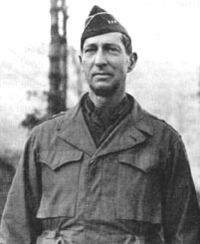
Italy: Rome is liberated by allied troops (US 9th Army) with the US General Mark Clark leading the way into the city.
War at Sea: U-505 becomes the first submarine captured and boarded on the high seas.
1946 Nuremberg Tribunal: Jodl defends his role in the infamous 'Commando Order.':
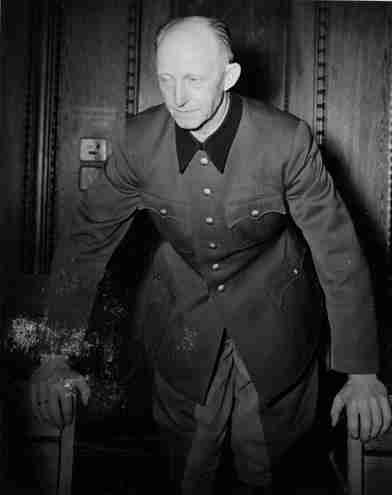
[The Fuehrer turned] to Field Marshal Keitel and to me and demanded an executive order . . . he added: "But I do not want any military courts" . . . . I had very many doubts which a careful study of the Hague rules of warfare could not dispel. My wish was an entirely different one. It was my intention to avoid an order altogether . . . .
Then on 17 October General Schmundt, the Chief Adjutant of the Fuehrer, came to me and said that the Fuehrer was demanding an executive order. I gave him the following answer, word for word: "Please give him my best regards, but I will not issue an order like that." Schmundt laughed and said, "Well, I cannot tell him that," and my reply was, "Very well, then, tell the Fuehrer that I do not see how a decree like that could be justified under international law." And with that he left. I hoped now that I would be asked to come to the Fuehrer, so that at last, after many months, I should again be able to speak to him personally . . . . I wanted an opportunity either of telling him my misgivings or else being thrown out altogether. Either eventuality would have helped me but neither occurred. A few minutes later Schmundt called me on the telephone and informed me that the Fuehrer was going to draw up the orders himself.
On 18 October Schmundt again came in person and brought with him these two orders of the Fuehrer-the order to the troops, and an explanation for the commanders . . . . there is the proposal which the foreign division of the intelligence department made: "Members of terrorist and sabotage troops who are found . . . . without uniform, or in German uniform, will be treated as bandits . . . . or if they fall into German hands outside battle operations, they are to be taken at once to an officer for interrogation. Thereafter they are to be dealt with by summary court martial."
That was quite impossible, for if one came across a soldier in civilian clothing, without uniform, no one could know just who he was. He might be a spy or an escaped prisoner of war or an enemy airman who had saved his life by jumping from his plane and now hoped to escape in civilian clothing. That had to be determined by an experienced interrogating officer and not by a summary court martial consisting of a lieutenant, two noncommissioned officers, and two soldiers . . . .
The theory was that soldiers, who by, their actions put themselves outside the laws of war, cannot claim to be treated in accordance with the laws of war. This is a basic principle definitely recognized in international law, for instance in the case of a spy or a franc-tireur. The aim of this order was to intimidate British Commando troops who were using such methods of warfare. But the order of the Fuehrer went further and said that all Commando troops were to be massacred. This was the point on which I had grave misgivings.[For further details, Click here]
1965 Walt takes command of 3rd Marine Division:
[For further details, Click here. Couldn't resist it.—Ed.]
Edited by Levi Bookin (Copy editor)
levi.bookin@gmail.com



Click to join 3rdReichStudies


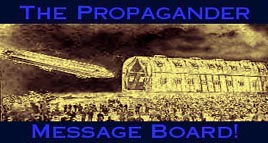

Disclaimer: This site includes diverse and controversial materials—such as excerpts from the writings of racists and anti-Semites—so that its readers can learn the nature and extent of hate and anti-Semitic discourse. It is our sincere belief that only the informed citizen can prevail over the ignorance of Racialist "thought." Far from approving these writings, this site condemns racism in all of its forms and manifestations.
Fair Use Notice: This site may contain copyrighted material the use of which has not always been specifically authorized by the copyright owner. We are making such material available in our efforts to advance understanding of historical, political, human rights, economic, democracy, scientific, environmental, and social justice issues, etc. We believe this constitutes a "fair use" of any such copyrighted material as provided for in section 107 of the US Copyright Law. In accordance with Title 17 U.S.C. Section 107, the material on this site is distributed without profit to those who have expressed a prior interest in receiving the included information for research and educational purposes. If you wish to use copyrighted material from this site for purposes of your own that go beyond 'fair use', you must obtain permission from the copyright owner.
Please Note: The list-owner and moderators of 3rdReichStudies are not responsible for, and do not necessarily approve of, the random ads placed on our pages by our web server. They are, unfortunately, the price one pays for a 'free' website.